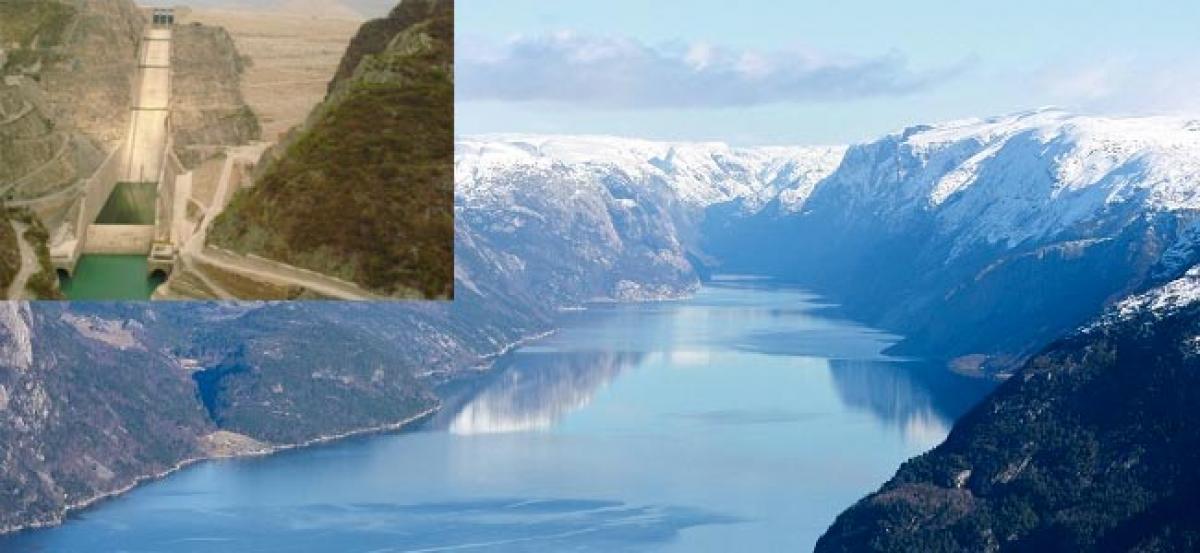Live
- Manipur bodies recovery: Widespread mob violence reported, curfew imposed, mobile internet suspended
- WPGT 2024: Hitaashee doubles lead to six shots in 14th Leg; Nayanika Sanga, Vidhatri Urs in pursuit
- Waqf row: BJP to stage protests before DC offices across Karnataka
- Disinformation major challenge, says Pak army chief after drawing flak on social media
- Digital media platforms must curb fake news, safeguard democracy: Ashwini Vaishnaw
- BJP wants to form govt in Jharkhand to loot its natural resources: Kharge
- Germany's healthcare sector hit by skilled labour shortages
- Mallikarjun Kharge predicts INDIA bloc’s victory in Jharkhand, promises to fulfill seven guarantees
- Israel renews attacks on Beirut's southern suburbs after evacuation call
- Uzbekistan continues gas accounting, control to ensure stable supply
Just In

Of the 177 hydropower projects (HPP) located close to Himalayan glaciers over a fifth -- including many in India -- could be under threat from floods caused by the outbursts of glacial lakes, European researchers have warned.
Kolkata: Of the 177 hydropower projects (HPP) located close to Himalayan glaciers over a fifth -- including many in India -- could be under threat from floods caused by the outbursts of glacial lakes, European researchers have warned.
The researchers, from various universities, have charted out a new method for locating the minimum exposure that hydropower sites in the Himalayas have to glacial lake outburst floods (GLOF) -- a type of outburst flood that occurs when the dam containing a glacial lake fails.
Himalayan water resources attract a rapidly-growing number of HPPs to satisfy Asia's soaring energy demands. Yet, the projects now operational or at a planning stage in steep, glacier-fed mountain rivers face hazards of GLOFs that can damage hydropower infrastructure, alter water and sediment yields and compromise livelihoods downstream.
The researchers evaluated the regional exposure of 257 Himalayan HPPs to GLOFs and assessed the flood risk to them from 2,359 moraine-dammed glacial lakes.
Moraines are dirt and rock debris that have been pushed along by glaciers as they move. The moraines form a dam containing lakes when the glaciers recede. But as glaciers further recede and the lake becomes larger, they are susceptible to giving way -- unleashing a flood that could threaten HPPs downstream.
"The number of hydroelectric power projects in the Himalayas has been increasing during the last decades and many more are planned. This trend has led to increasing implementation of the projects on rivers higher up and closer to glaciers," the study's lead author, Wolfgang Schwanghart, a geologist at the Institute of Earth and Environmental Sciences, University of Potsdam, Germany, told IANS in an email interaction.
"Our key result is that the majority of the projects are currently planned or constructed where these uncertainties become relevant and potentially dangerous," he added.
Most of the sampled hydropower projects are in the Indian Himalayan states of Himachal Pradesh, Uttarakhand and Sikkim, and some in Nepal and Bhutan.
"Our database encompasses 257 HPPs, 177 of which are located on potential GLOF tracks. In 56 HPP (one fifth of 177), the volume of floodwater may exceed the limit they are designed to withstand," explained Schwanghart.
The striking factor, said Schwanghart, is the density of dams in Sikkim in northeast India.
"Particularly, Sikkim stands out as a region combining abundant glacial lakes, long potential GLOF tracks, and pronounced hydropower development. Several regions in Eastern Nepal and Bhutan also host lakes that could give rise to far-reaching GLOFs," he said.
Strategies for climate change mitigation and adaptation at the sub-national level are currently prepared by Indian Himalayan states (State Action Plans on Climate Change), and identify GLOFs as a major climate change-related threat to hydropower development (Government of Uttarakhand, 2014), the study says.
At the same time, however, hydropower is being harnessed in a major way in these states to meet the increasing power demand and advance low-carbon economies.
"Disregarding the current upstream increase of uncertainties about GLOF discharges for HPP to be located in headwaters may undermine some of the coordination between climate-change mitigation, adaption, and energy plans," the study warns.
Published in the journal Environmental Research Letters, the analysis also involves experts from the University of Geneva and University of Switzerland.
The experts used high-resolution remote sensing imagery from Google Earth for mapping glacial lakes, as well as publicly available digital elevation models.
Run-off data are scarce in the Himalayas due to restrictive data policies. Data on HPPs were mined from various sites in the internet including those of many hydropower companies, the Indian Power Ministry, the UN, and the World Bank, Schwanghart said, adding the study does not factor in climate change.
The scientists used computer simulations to determine how much floodwater might be released from such lakes, if the moraine embankments fail and how far the water would travel.
"India has a great share of its hydropower in the Himalayas. This share is likely to increase in the future. The high vulnerability to flash floods during the Indian floods suggests a high vulnerability to GLOFs, too.
"However, large parts of the Indian Himalayas are not among those areas that experience the strongest glacier retreat rates. However, this might change in the future and highlights the necessity for reliable climate change projections and its influence on Himalayan glacier retreat, and ultimately the development of glacial lakes," Schwanghart cautioned.

© 2024 Hyderabad Media House Limited/The Hans India. All rights reserved. Powered by hocalwire.com







